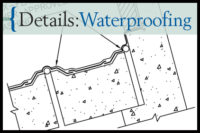C oncrete slab control joints are non-moving joints that are placed and sized for expected cracking or shrinking. The most important issues regarding sealant design are joint depth, joint width and the spacing of the joints. Sealant application must be controlled by a backing system that controls the depth of the sealant and prevents three-sided adhesion. The sealant should have a concave shape.
Materials
• Sealant: Polyurethane sealant.
• Backer rod: Closed-cell polyethylene foam.
Basic Rules for Joint Design
1. The joint size shall be no smaller than ¼ inch.
2. The joint size shall be no larger than 1 inch.
3. The joint opening shall be a minimum of four times the anticipated movement rate.
Basic Rules for Sealant Design
1. The material thickness shall be no less than ¼ inch.
2. For joints up to ½ -inch wide, the depth of the material shall equal the width of the material.
3. For joints wider that ½ inch, the depth of the material is equal to the width of the material.
4. The maximum recommended width is 1 inch.
5. The maximum recommended depth is ½ inch.
Determination of Number and Spacing of Joints
The anticipated substrate movement is determined by the coefficient of expansion, the length of the material span, and the joint width.
Waterproofing Concrete Control Joints
Looking for a reprint of this article?
From high-res PDFs to custom plaques, order your copy today!



